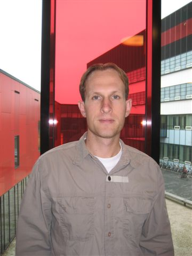Miniaturized electrochemical cells. For applications in drug screening and protein cleavage.
Promotion date: 2. March 2011
Promotor: Prof. Dr. Albert van den Berg
Assistant promotor: Dr. W. Olthuis
| A small flow-through electrochemical cell in a lab-on-chip format is studied. This cell contains a complete, integrated 3-electrode setup with platinum working and counter electrodes and a palladium or iridiumoxide pseudo-reference electrode. Using this cell type, the turnover rate of small and fast reacting ions is found to be near 100%. Also, the cell is used to mimic the oxidative metabolism of the enzyme CYP450. The cell can be used to screen drugs at an early stage of development. The electrochemical cell on-chip was able to generate main metabolites of two important drugs. |
In what way can the cell be of use to screen drugs?
In the early stages of developing medicine, typically thousands of working agents have to be tested, to see if the drug is active in the right way. Also it is crucial to know in what way the drug is digested in the liver, perhaps leaving dangerous by-products but best remaining active as intended.
Using on-chip technology - able to replicate real life processes - can help a great deal to test large amounts of chemicals, synthesizing efficiently, saving a lot of money and time. The harvesting of chemicals can be tough, as they are hard to isolate sometimes. Now, only little amounts are needed which can be tested in a proven manner.
Did your thesis work lead to exposure?
As a scientist, I had some nice articles published and I performed as a speaker on conferences all over the world. Also, my work was broadly mentioned in the media, appearing on national radio even. I was very pleased with this exposure, as it is a recommendation of one’s work, and also to the subsidizing organisation STW and the companies involved.
Will there be a continuation of your work?
I certainly hope so. In the lab-on-a-chip group, I was one of the few scientists, active for medicine applications. A follow-up request is underway.
Now the principle is proven, the next main challenge is to further miniaturization and improving integration of the microchip to surrounding measuring apparatus, for example the mass spectrometer. A lot of functionality is needed on a relatively small area, including high voltage to accelerate ions and a complex design of reaction dimension mechanisms, eventually leading to couplings with surrounding apparatus. This process involves engineering. Also quite fundamental issues have to be settled first.
What are your future plans? Are you going to work on this, if possible?
I am going to work as a post-doc, as part of the Spinoza project on migraine, in close collaboration with the University of Leiden and Wageningen. Our task is to develop novel sensors to study the mechanisms responsible for the beginning of migraine events. We are especially interested in an effect called cortical spreading depression, an effect which can be compared to an avalanche spreading in the brain that inhibits neuron activity. In the project we are looking to find the cause of this avalanche, which is an exciting challenge, and very important too.
In what way are you going to put in the skills you have been building up?
Both sides of scientific work I enjoy very much so, be it theoretical or experimental. Using computer simulations, before building experiments, I gained experience with.
Most of the time, one is very aware of one’s own development in his profession. Being an expert on lab-on-a-chip design, I now can switch very swiftly from one application in the field to the other.
What is important for Mesa+, in your opinion, to stay successful in the future?
The open and flexible organization is a big selling point, I believe. I hope in future technicians remain open minded, allowing scientists to perform experiments that are contra-intuitive at first glance. In this way, lab experts and scientists continue to make a strong combination.

